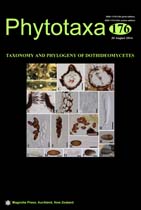Abstract
The family Englerulaceae presently includes seven genera that produce brown to dark-brown colonies on living leaves. Ascomata are superficial and scattered on the colonies and lack ostioles. Asci are 2–8-spored, bitunicate, ovate to globose and ascospores are multi-seriate, oblong to ellipsoid, brown, and smooth-walled with a single septum. This paper brings all genera of the family together in one place with descriptions and illustrations and discusses their current taxonomic placement. The type species of Englerula, Parenglerula, Rhizotexis, Rhytidenglerula, Schiffnerula and a new species of Thrauste are redescribed and illustrated with light photomicrographs, in this paper. It is suggested that Butleria should be accommodated in Myriangiaceae. Rhizotexis is excluded from the family and moved to Dothideomycetes genera incertae sedis, as morphological characters are not similar to type genus and other genera in the family. The type specimen of Goosia is missing and is redrawn from the protologue. By illustrating and redescribing the genera we expect renewed interest for recollection and molecular study so that these dothideomycetous genera can be placed in a natural taxonomic framework.

